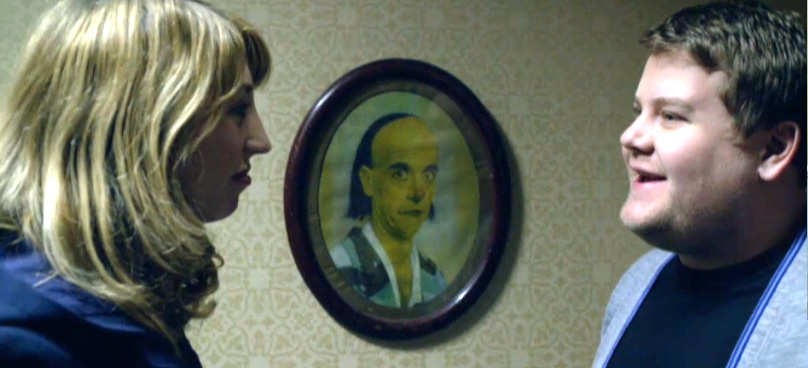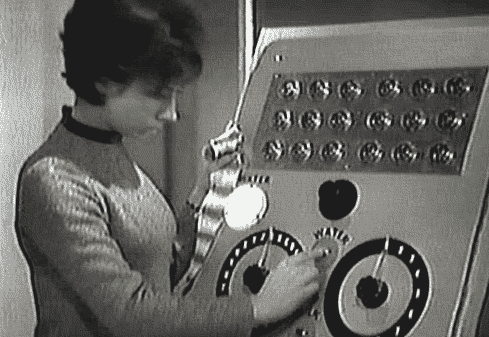“Docteur Qui is difficult enough to explain in English”
Once during practice for oral French my teacher asked me what my favourite TV programme was and I said Docteur Qui. She then asked me to describe it. Docteur Qui is difficult enough to explain in English and I’m afraid my sparse French didn’t suffice. She suggested if asked this question during the exam I should tell a white lie and pick something simpler. I chose Roobarb and Custard, a cartoon about a chat et un chien, which seemed more straightforward, but it didn’t help because I failed oral French anyway.
I don’t in any way mean this as a slight — Matthew Waterhouse (who portrayed Alzarian boy genius Adric in the late Tom Baker, early Peter Davison era of Doctor Who) seems to possess a charming naïveté and capacity for non sequitur that reminds me of the most sublime moments of Karl Pilkington.
The above, taken from his blog, is a recent example.
“Typical instances from separate epistopic interfaces of the spectrum”
“It was a hack of and for its time, done for the curiosity and the glory of simply doing it”
I was reading the Wikipedia entry for an episode of Doctor Who I was watching last night when I happened upon this anecdote (new to me but apparently well-known) about the broadcast of the story on Chicago station WTTW being interrupted by a pirate transmission.
The first occurrence of the signal intrusion took place during then-independent station WGN-TV’s live telecast of its primetime newscast, The Nine O’Clock News. During Chicago Bears highlights in the sports report, the station’s signal was interrupted for about half a minute by a video of a person wearing a Max Headroom mask, moving around in front of a sheet of corrugated metal, which imitated the background effect used in the Max Headroom TV and movie appearances. There was no audio other than a buzzing noise. (…)
Later that night, around 11:15 p.m. Central Time, during a broadcast of the Doctor Who serial ‘Horror of Fang Rock’, PBS member station WTTW’s signal was hijacked using the same video that was broadcast during the WGN-TV hijack, this time with distorted audio.
As Chris Knittel and Alex Pasternack’s comprehensive account of this infamous ‘broadcast intrusion’ concludes, ‘there was no clear motive, no clear message, and thirty years on, no clear perpetrator’.
“This suggestion that the TARDIS uses some kind of osmosis for taking in oxygen from outside fails to address the fact the ship can float in space for an indefinite period with no problems”
We are lead to believe that if the outer shell of [the TARDIS] becomes coated in green jizz, then the occupants suffocate in about four minutes.
Must confess to being slightly alarmed to encounter this digression while reading an otherwise jizz-free history of the TARDIS interior roundels.
“I think the costume was possibly something of a mistake”

In the cold light of day, years after the event, I can say I think the costume was possibly something of a mistake.
John Nathan-Turner, producer of Doctor Who from 1980–1989, in reflective mood during The John Nathan-Turner Memoirs.
“There isn’t a single, definitive Doctor Who, but a whole bunch of mutually contradictory, but mutually-reflecting, continuities”
It’s only really when [Doctor Who] returns in 2005 that a singular narrative is imposed again. The effect is rather like the way that, after a mass extinction (in this case the extinction of the TV programme), very quickly whole new ecological niches will open up and biodiversity will increase rapidly, before (as in this case) a new apex predator (the new series) comes along and causes another wave of extinctions.
Andrew Hickey on the influence of Virgin’s Doctor Who New Adventures novel series — one of the major sources of new Doctor Who stories during the period in which the program was off the air.
“Consider the near-miss universe where Doctor Who’s spinoff is instead the downright alarming show Hot Cow Rod“
Torchwood itself is a parodic mirror of Doctor Who – its original function was as a decoy name for shipping film of Doctor Who, the name an anagram of ‘Doctor Who’. […] The idea that Torchwood mirrors Doctor Who is telling, as Torchwood is tacitly presented as the answer to the question ‘what happens when the Doctor doesn’t show up.’ They are defenders of Britain, and, like the Doctor, quintessentially Britain, stemming out of a long British tradition and particularly from the iconography of the Victorian era. But where the Doctor is the eccentric gentleman inventor and the old man guarding the gates to fairy, Torchwood is the militaristic ambition of glorious empire.
Philip Sandifer reviews the Doctor Who series two finale, ‘Army of Ghosts / Doomsday’.
“The first televised (Doctor Who) story since ‘The Web Planet’ to feature no humanoid characters other than the regulars”
Fundamentally, a bunch of aliens milling about to ‘Tainted Love’ just isn’t that strange a sight for a 2005 television audience.
Philip Sandifer’s epic ongoing critical history of Doctor Who
has reached the 2005 relaunch. This instalment covers one of my personal favourite episodes of the series, classic and new: ‘The End of the World’.
“You can’t escape your destiny, which is to fall, helplessly”
Hard science: What Christopher Bidmead wanted to reintroduce to Doctor Who. Judging from the script to Logopolis, hard science consists of millions of chanting monks in a city made to look like a brain, chanting block transfer mathematics codes in order to counteract entropy, while the ghost of someone’s future self tells him the future in order to cause it.
From Andrew Hickey’s excellent lexicon for the 1981 Doctor Who serial ‘Logopolis’, in which Tom Baker’s Doctor (cheekily designated here as the twelfth incarnation) regenerates after a fatal fall from a radio telescope. (Or, as Hickey puts it in his entry on gravity: if you place a Time Lord with an approximate mass of 70kg at the top of a radio telescope, say Jodrell Bank, 89m above a planet with mass 5.972×10^24kg, and then have him let go, he will hit the planet a little over three seconds later
.)
‘Logopolis’ and its sequel ‘Castrovalva’ seem to me to be stories that could only be told within the world of Doctor Who, concerned as they are with the manipulation, destruction and reconstruction of the show’s unique central icons: the Doctor and the TARDIS. One could go further and say that another of the show’s unique qualities is its acceptance of and dependance upon this same process of reconstruction.
“As highly praised as Doctor Who is by its viewers, the programme praises itself even more”
All this self-mythologising isn’t very British, frankly. It is off-putting, too, especially as (the Doctor) was conceived, in 1963, as a dotty old meddler in a time machine that did not work properly. The essence of his charm was that he was not an intergalactic superhero in the Flash Gordon mould, but a wandering eccentric. The programme was a celebration of the nerdy underdog, not the strutting bully-boy that the Doctor has become.
Hits the Dalek right in the eyestalk. (Thanks to @timsterne for the link.)
“The final battle is fought out in the tiniest part of TC3 at Television Centre”
I think Douglas Adams writing [Doctor Who] to order for the BBC in 25-minute instalments with this many sets and that many actors is very different from Douglas Adams the radio writer, or Douglas Adams the novelist. The stage directions are peppered through with things like, ‘As many explosions as we can manage’ or, ‘K-9 comes out at what passes for full speed’.
Gareth Roberts on his novelisation of ‘Shada’, a 1979 Doctor Who serial penned by (then script editor) Douglas Adams. The story was abandoned mid-production because of BBC industrial action triggered by a demarcation dispute over the operation of the Play School clock (yes, really), and though the extant footage has been released on home video (with linking narration by Tom Baker), this is the first time the story has been officially adapted in print.
The two other stories Adams wrote for Who — ‘The Pirate Planet’ and the classic ‘City of Death’ — are yet to be (officially) novelised.
“I begin to lose hope that I will ever meet Tegan”
One father’s determination against the odds. One gutsy yellow Austin 1100. And one twelve-year-old boy’s prepubescent lust for a ‘sexy air hostess’. A very special road trip to Longleat in 1983 for the Doctor Who 20th anniversary celebration.
From Totter’s Lane to…?
Wired UK has an infographic of the TARDIS’s journeys through time over 50 years of the Doctor’s televised history.
“Gatiss has made a career out of indulging his boyhood obsessions”
League of Gentleman and Sherlock co-creator and regular Doctor Who contributor Mark Gatiss is helping to unleash some ‘pent-up camp’ in the current series of BBC Three’s flatshare telefantasy Being Human.
Answered (partly): the most puzzling mystery in Doctor Who since… well, since every creative decision made by producer John Nathan-Turner from 1984 onwards
Doctor Who scribe Gareth Roberts has, via Twitter, supplied the answer to a question that has puzzled Who fans and casual observers since the broadcast of his 2010 episode ‘The Lodger’: “What in the name of the Terrible Zodin is the deal with that creepy painting?!?’

Turns out it’s a portrait of Victorian music hall entertainer Dan Leno. But questions remain. Why is it there? Is it significant? Is that what Nick Cave would look like if he shaved off his new moustache?
(Thanks to @matchtrick for the tip-off)
“I declare this wang-tank… open!”
Bugle spoiler alert: the latest episode has both producer Chris and producer Tom in it! It’s pretty much The Three Doctors of Bugle episodes! (Except with wall-to-wall plum-jokes.)
F___ you Chris!
“Like the food machine, you mean”

Humankind moves one step closer to artificial food. (Image via the arrangement of nerves in a leaf)
He’s a blackguard, that Black Guardian
It’s a long-established rule of fantasy that the more powerful and ethereal a being is, the more freely he can indulge his latent transvestism.
That’s Gary Gillat describing the evil (no, really?) Black Guardian from Doctor Who, in his 2009 review of the ‘Black Guardian Trilogy’ DVD box set.
“As if time itself were gnawing at its own entrails”
Mike Lynch at Nannygoat Hill offers an examination of Doctor Who, its central character and its enthusiasts in the form of a Ballardian short fiction-cum-psychiatric essay, as though the program itself were a series of ‘disaster reports’ detailing ever-increasing threats to humanity, the universe, and temporal reality itself; metaphors, as the essay suggests, “for some crisis of the mind’s ability to retain an integral image of itself over historical time”.
